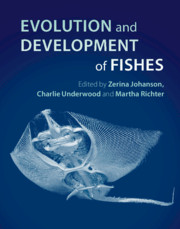Book contents
- Evolution and Development of Fishes
- Evolution and Development of Fishes
- Copyright page
- Contents
- Contributors
- Introduction
- 1 The Evolution of Fishes through Geological Time
- 2 Comparative Development of Cyclostomes
- 3 The Ordovician Enigma
- 4 The Evolution of Vertebrate Dermal Jaw Bones in the Light of Maxillate Placoderms
- 5 Doliodus and Pucapampellids
- 6 The Evolution of Endoskeletal Mineralisation in Chondrichthyan Fish
- 7 Plasticity and Variation of Skeletal Cells and Tissues and the Evolutionary Development of Actinopterygian Fishes
- 8 Origin, Development and Evolution of the Fish Skull
- 9 Evolution, Development and Regeneration of Fish Dentitions
- 10 Development of Head Muscles in Fishes and Notes on Phylogeny-Ontogeny Links
- 11 Evolutionary Development of the Postcranial and Appendicular Skeleton in Fishes
- 12 Evolution of Vertebrate Reproduction
- 13 Links between Thyroid Hormone Alterations and Developmental Changes in the Evolution of the Weberian Apparatus
- 14 Pharyngeal Remodelling in Vertebrate Evolution
- 15 Evolution of Air Breathing and Lung Distribution among Fossil Fishes
- Index
- References
8 - Origin, Development and Evolution of the Fish Skull
Published online by Cambridge University Press: 31 December 2018
- Evolution and Development of Fishes
- Evolution and Development of Fishes
- Copyright page
- Contents
- Contributors
- Introduction
- 1 The Evolution of Fishes through Geological Time
- 2 Comparative Development of Cyclostomes
- 3 The Ordovician Enigma
- 4 The Evolution of Vertebrate Dermal Jaw Bones in the Light of Maxillate Placoderms
- 5 Doliodus and Pucapampellids
- 6 The Evolution of Endoskeletal Mineralisation in Chondrichthyan Fish
- 7 Plasticity and Variation of Skeletal Cells and Tissues and the Evolutionary Development of Actinopterygian Fishes
- 8 Origin, Development and Evolution of the Fish Skull
- 9 Evolution, Development and Regeneration of Fish Dentitions
- 10 Development of Head Muscles in Fishes and Notes on Phylogeny-Ontogeny Links
- 11 Evolutionary Development of the Postcranial and Appendicular Skeleton in Fishes
- 12 Evolution of Vertebrate Reproduction
- 13 Links between Thyroid Hormone Alterations and Developmental Changes in the Evolution of the Weberian Apparatus
- 14 Pharyngeal Remodelling in Vertebrate Evolution
- 15 Evolution of Air Breathing and Lung Distribution among Fossil Fishes
- Index
- References
Summary
The evolutionary origin of the brain and braincase of fishes remains largely elusive. The development of the vertebrate skull is dependent on the presence of an embryonic neural crest whose cells migrate to induce the formation of various elements of the cranial skeleton, dentitions and certain soft tissues. Much progress has been made in the understanding of the vertebrate skull since pioneering anatomical descriptions made last century. In the last few decades, studies involving micro-anatomy, ontogenetic development, molecular biology and gene expression have shed light on key developmental processes that seem to be widely shared among vertebrates. However, molecular biology and ontogenetic studies have been restricted to a small number of fish species. There is still much uncertainty about precise homologies between parts of the skull of distinct groups of fishes, due to the fact that the vertebrate skull shows a remarkable morphological and anatomical plasticity.
- Type
- Chapter
- Information
- Evolution and Development of Fishes , pp. 144 - 159Publisher: Cambridge University PressPrint publication year: 2019

